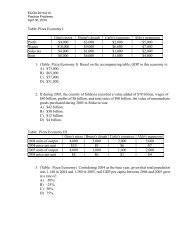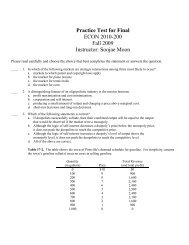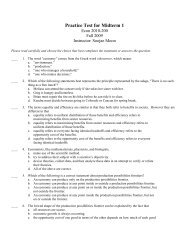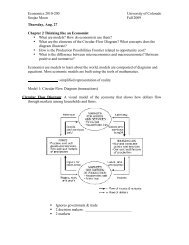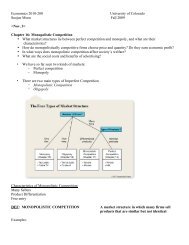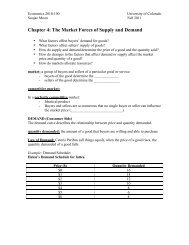Create successful ePaper yourself
Turn your PDF publications into a flip-book with our unique Google optimized e-Paper software.
Economics 2010-100<br />
University of Colorado<br />
Soojae Moon Fall 2011<br />
<strong>Chapter</strong> 2 <strong>Thinking</strong> <strong>like</strong> <strong>an</strong> <strong>Economist</strong><br />
• What are models How do economists use them<br />
• What are the elements of the Circular-Flow Diagram What concepts does the<br />
diagram illustrate<br />
• How is the Production Possibilities Frontier related to opportunity cost What<br />
other concepts does it illustrate<br />
• What is the difference between microeconomics <strong>an</strong>d macroeconomics Between<br />
positive <strong>an</strong>d normative<br />
<strong>Economist</strong>s play two roles: Scientists <strong>an</strong>d Policy advisors<br />
Model:<br />
Model 1: Circular Flow Diagram<br />
Circular Flow Diagram:<br />
Two types of “actors”:<br />
Two markets:<br />
Factors of production:<br />
FIGURE 1: The Circular-Flow Diagram<br />
Revenue<br />
G & S<br />
sold<br />
Markets for<br />
Goods &<br />
Services<br />
Spending<br />
G & S<br />
bought<br />
Firms<br />
Households<br />
Factors of<br />
production<br />
Wages, rent,<br />
profit<br />
Markets for<br />
Factors of<br />
Production<br />
Labor, l<strong>an</strong>d,<br />
capital<br />
Income<br />
THINKING LIKE AN ECONOMIST 11<br />
§<br />
§<br />
Outer loop reps flows of income/payments between hh & firms<br />
Inner loop reps flows of inputs <strong>an</strong>d outputs between hh & firms
Economics 2010-100<br />
University of Colorado<br />
Soojae Moon Fall 2011<br />
Model 2: Production Possibilities Frontier (Tradeoffs)<br />
PPF:<br />
Example: Produce 2 goods: computers & wheat, 50,000 labor hours per month available<br />
PPF Example<br />
! Producing one computer requires 100 hours labor.<br />
! Producing one ton of wheat requires 10 hours labor.<br />
Employment of<br />
labor hours<br />
Computers<br />
Wheat<br />
Computers<br />
Production<br />
Wheat<br />
A<br />
50,000<br />
0<br />
500<br />
0<br />
B<br />
40,000<br />
10,000<br />
C<br />
25,000<br />
25,000<br />
D<br />
10,000<br />
40,000<br />
E<br />
0<br />
50,000<br />
0<br />
5,000<br />
Wheat<br />
(tons)<br />
6,000<br />
5,000<br />
4,000<br />
3,000<br />
2,000<br />
1,000<br />
0<br />
0 100 200 300 400 500 600<br />
Computers
Economics 2010-100<br />
University of Colorado<br />
Soojae Moon Fall 2011<br />
Economic Growth <strong>an</strong>d the PPF: ch<strong>an</strong>ge in technology, ch<strong>an</strong>ge in resources.<br />
The shape of PPF: straight line, or bow-shaped<br />
Why the PPF Might Be Bow-Shaped<br />
As the economy<br />
shifts resources<br />
from beer to<br />
mountain bikes:<br />
! PPF becomes<br />
steeper<br />
! opp. cost of<br />
mountain bikes<br />
increases<br />
Beer<br />
Mountain<br />
Bikes<br />
THINKING LIKE AN ECONOMIST 24<br />
microeconomics:<br />
macroeconomics:<br />
positive statements (descriptive, based on fact, Was, is, will):<br />
normative statements (value judgment, prescriptive, Should, ought):<br />
Suggested Problems: Problems <strong>an</strong>d Applications- 4, 5, 6



